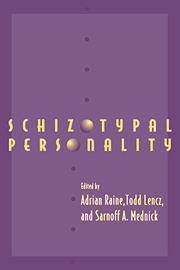Book contents
- Frontmatter
- Contents
- List of contributors
- Preface
- Acknowledgments
- Part I Introduction
- Part II Genetics and neurodevelopment
- Part III Assessment
- Part IV Categorical versus dimensional approaches
- 7 Tracking the taxon: on the latent structure and base rate of schizotypy
- 8 Detection of a latent taxon of individuals at risk for schizophrenia-spectrum disorders
- 9 Fully and quasi-dimensional constructions of schizotypy
- Part V Psychophysiology and psychopharmacology
- Part VI Neuropsychology
- Part VII Brain imaging
- Part VIII Conclusion
- Part IX Appendix
- Name Index
- Subject Index
8 - Detection of a latent taxon of individuals at risk for schizophrenia-spectrum disorders
from Part IV - Categorical versus dimensional approaches
Published online by Cambridge University Press: 04 August 2010
- Frontmatter
- Contents
- List of contributors
- Preface
- Acknowledgments
- Part I Introduction
- Part II Genetics and neurodevelopment
- Part III Assessment
- Part IV Categorical versus dimensional approaches
- 7 Tracking the taxon: on the latent structure and base rate of schizotypy
- 8 Detection of a latent taxon of individuals at risk for schizophrenia-spectrum disorders
- 9 Fully and quasi-dimensional constructions of schizotypy
- Part V Psychophysiology and psychopharmacology
- Part VI Neuropsychology
- Part VII Brain imaging
- Part VIII Conclusion
- Part IX Appendix
- Name Index
- Subject Index
Summary
Family, twin, and adoption studies have demonstrated that there is a substantial genetic component to the etiology of schizophrenia (Gottesman & Shields, 1982; Tsuang, Gilbertson, & Faraone, 1991). Genetic factors cannot fully explain transmission of schizophrenia, however, because concordance in monozygotic twins, who are genetically identical, is on the order of 50% (Gottesman & Shields, 1982; Kendler, 1983). These observations have led several investigators to propose diathesis – stress models of schizophrenia (Cannon & Mednick, 1993; Meehl, 1962, 1989, 1990; Nuechterlein et al., 1992; Shields et al., 1975). In its most general form, this model predicts that schizophrenia results from the interaction of genetic liability with particular environmental stressors; neither genetic nor environmental factors alone are believed to be sufficient to give rise to the disorder. Paul Meehl (1962, 1989, 1990), following Rado (1953), has further proposed that genetic vulnerability to schizophrenia is expressed in a variety of subpsychotic signs (i.e., cognitive slippage, social aversiveness, anhedonia, and ambivalence) that are unified in the construct “schizotypy.” In this framework, schizotypy is thought to be the basic genetic condition; schizophrenia is an environmentally provoked complication of schizotypy.
In this chapter we review recent empirical findings from a prospective, longitudinal study of offspring of schizophrenic parents which support and further specify the hypotheses summarized above. Specifically, we report on a series of taxometric analyses that attempt to discern whether schizotypal symptoms and signs assessed during childhood, young adulthood, and middle age define a latent class of individuals with high risk for developing schizophrenia-spectrum disorders, and we examine the stability of schizotypal class membership across the life-span.
Keywords
- Type
- Chapter
- Information
- Schizotypal Personality , pp. 168 - 191Publisher: Cambridge University PressPrint publication year: 1995
- 5
- Cited by



